
Background
The ASEAN region is experiencing significant growth, with its member states advancing to higher income levels. This development, coupled with urbanization and population growth, is leading to an increased demand for food, water, energy, products, and services. This surge in demand, stemming from both domestic and international markets, is exerting unprecedented pressure on natural resources, climate, and the environment. The evidence of a triple planetary crisis - encompassing climate change, biodiversity loss, and the accumulation of waste and pollution - is becoming increasingly apparent. This crisis is primarily driven by unsustainable practices in the use of materials, energy, water, and other resources.
Recognizing the need to disentangle economic growth from the escalating consumption of natural resources and its associated environmental impacts, ASEAN and its member states are emphasizing the importance of Circular Economy (CE) and Sustainable Consumption and Production (SCP). These concepts are crucial for achieving economic resilience, resource efficiency, and sustainable growth. Transitioning to a circular economy is vital for moving the region away from a resource-intensive model, thereby mitigating the aforementioned triple planetary crises. By adopting renewable resources, practicing resource efficiency, and ensuring circular usage, a transformative shift towards a low-carbon, circular model can be initiated. The ultimate goal of this transition is to achieve net zero impact on climate, nature, biodiversity, pollution, and waste.
Businesses and industries play a pivotal role in actualizing this transition to a circular economy by developing and providing 'circular' products and services, as well as by innovating in production, distribution, and recovery systems. Without their participation, the circular economy will struggle to gain momentum. As key stakeholders, the perspectives, needs, opportunities, and constraints of industry and business must be considered in shaping policies that enable this transition, addressing technological, financial, and market barriers, and vice versa.
However, the concept of the circular economy is subject to varied interpretations and ambiguous implementations across sectors, leading to scepticism about its effectiveness. Fundamentally rooted in the 3Rs concept of reduce, reuse, and recycle, the circular economy also encompasses broader strategies such as refusing, rethinking, repairing, refurbishing, remanufacturing, repurposing, and recovering, as exemplified in the EU's 9Rs strategy. Despite these expansions, a clear hierarchy within these strategies is still lacking. In contrast, the Waste Management Hierarchy offers a more structured approach, prioritizing prevention, reuse, repurposing, recycling, recovery, and ultimately disposal.
The value of recycling is widely recognized, offering convenient solutions and environmental benefits by diverting waste from incineration and landfills. Recycled materials, often of high quality and with a lower environmental footprint, also present economic advantages. They can be more cost-effective compared to virgin materials, thereby reducing trade dependency for critical materials and increasing self-sufficiency.
Nonetheless, recycling is not without its challenges. It can be a source of waste, pollution, and resource consumption, with processes often being less than 100% efficient. Losses of up to 15-20% of materials can occur, particularly during crushing, leading to issues like the creation of microplastics in plastic recycling. Additionally, energy, water, and other resources are needed throughout the recycling process, which can degrade material quality over time and lead to the accumulation of hazardous substances.
Furthermore, an overemphasis on recycling can undermine the essential principle of waste avoidance. A mentality that justifies consumption as long as materials are recycled obscures the reality that only a small fraction of waste, like 9% of global plastic waste, is actually recycled. The rest still contributes to environmental pollution. Therefore, it's crucial to recognize that the circular economy is more than just recycling; recycling should be seen as a last resort within this framework. Shifting the responsibility to producers to move away from a linear economy to a circular model further underscores the need for a comprehensive approach.
The recent 1.5-hour webinar "Making Circular Economy Work for Business and Industry," hosted by the ASEAN Circular Economy Stakeholder Platform and co-hosted by the EU SWITCH-Asia Policy Support Component, addressed these challenges. The webinar brought together experts in circular economy from global and ASEAN contexts, industry practitioners, and regional enablers to share perspectives, experiences, and insights on advancing the circular economy in the ASEAN region.
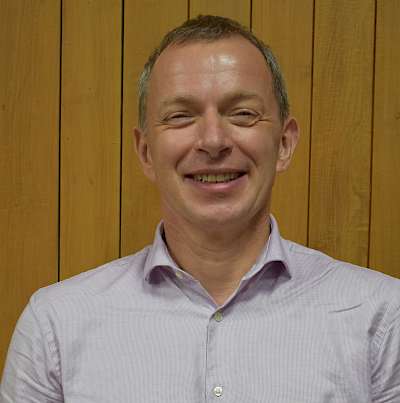 The event began with an overview of the ASEAN Circular Economy Stakeholder Platform, highlighting its role in consolidating and facilitating regional efforts. René Van Berkel, a Senior Expert in Circular Economy for the SWITCH-Asia Policy Support Component, presented a unifying framework for business action in ASEAN, emphasizing the need to move beyond viewing circular economy solely as recycling and waste management.
The event began with an overview of the ASEAN Circular Economy Stakeholder Platform, highlighting its role in consolidating and facilitating regional efforts. René Van Berkel, a Senior Expert in Circular Economy for the SWITCH-Asia Policy Support Component, presented a unifying framework for business action in ASEAN, emphasizing the need to move beyond viewing circular economy solely as recycling and waste management.
Industry practitioners shared their experiences in leading circular economy initiatives within the private sector, focusing on combating resource over-extraction and reducing waste generation. The final panel discussion brought together practitioners from various organizations to reflect on lessons learned, discuss strategies for moving forward, and explore opportunities for collaboration and knowledge sharing to enhance the implementation of circularity within the region and beyond.
This expert discussion culminated in five key questions that need addressing:
1. Who is the ASEAN Circular Economy Stakeholder Platform?
2. How can we streamline the definition and interpretation of Circular Economy?
3. What role can business and industry play in realizing Circular Economy?
4. What role can regional enablers play in realizing Circular Economy in ASEAN?
5. How can Circular Economy be implemented and scaled?
ASEAN Circular Economy Stakeholder Platform
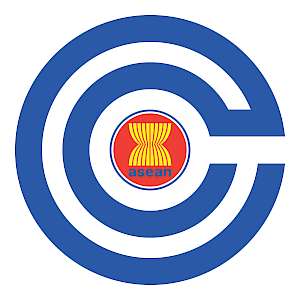
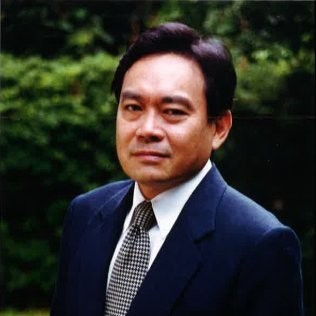
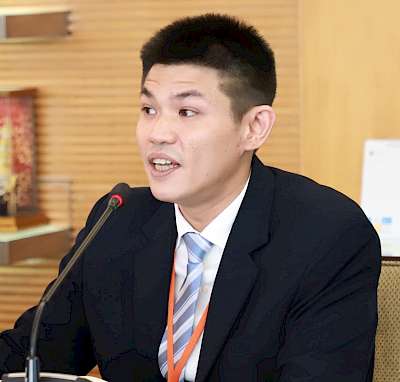 Anthony Pramualratana and Treesuvit (David) Arriyavat, Deputy Director and Project Manager respectively at the ASEAN Circular Economy Stakeholder Platform (ACESP), presented the objectives and mission of both the ASEAN Centre for Sustainable Development Studies and Dialogue (ACSDSD) and the ASEAN Circular Economy Stakeholder Platform. The ACSDSD, established in 2019, focuses on aligning the Sustainable Development Goals (SDGs) with the ASEAN region's development, as detailed in the Report “Complementarities between the ASEAN Community Vision 2025 and the United Nations 2030 Agenda for Sustainable Development: A Framework for Action." The ACESP, inaugurated in 2022 by the EU and ASEAN, operates as a regional hub supporting the transition towards a circular economy to promote sustainable consumption and production among ASEAN member states. It is part of the EU-ASEAN Partnership on Circular Economy, endorsed in 2018, and receives support from the Enhanced EU-ASEAN Dialogue Instrument (E-READI). Hosted by the ACSDSD, the ACESP's current efforts are also supported by the EU SWITCH-Asia Programme to facilitate the sharing of knowledge and experiences in circular economy and sustainable consumption and production.
Anthony Pramualratana and Treesuvit (David) Arriyavat, Deputy Director and Project Manager respectively at the ASEAN Circular Economy Stakeholder Platform (ACESP), presented the objectives and mission of both the ASEAN Centre for Sustainable Development Studies and Dialogue (ACSDSD) and the ASEAN Circular Economy Stakeholder Platform. The ACSDSD, established in 2019, focuses on aligning the Sustainable Development Goals (SDGs) with the ASEAN region's development, as detailed in the Report “Complementarities between the ASEAN Community Vision 2025 and the United Nations 2030 Agenda for Sustainable Development: A Framework for Action." The ACESP, inaugurated in 2022 by the EU and ASEAN, operates as a regional hub supporting the transition towards a circular economy to promote sustainable consumption and production among ASEAN member states. It is part of the EU-ASEAN Partnership on Circular Economy, endorsed in 2018, and receives support from the Enhanced EU-ASEAN Dialogue Instrument (E-READI). Hosted by the ACSDSD, the ACESP's current efforts are also supported by the EU SWITCH-Asia Programme to facilitate the sharing of knowledge and experiences in circular economy and sustainable consumption and production.
ACESP's main objectives include accelerating the ASEAN region's circular economy efforts through various platforms and initiatives and supporting these transitions by sharing policies, commitments, best practices, and success stories. Additionally, it provides an information portal on circular economy, fosters stakeholder engagement, and organizes annual conferences and events with diverse participation.
During this session, René Van Berkel, provided insights into the circular economy framework and proposed the Guiding Principles for Circular Economy Business Action as a roadmap for ASEAN industry leaders. He emphasized the urgency of moving beyond a linear and recycling-centric economy to a broader interpretation of circular economy. This shift is crucial to address the triple planetary crises: climate change, waste accumulation, and loss of nature. He argued that a circular economy should mirror nature's cyclical resource usage, aiming for greater economic output and services with minimal environmental impact and energy use.
Innovation is key in this transition, occurring at the product and service life cycle stages to optimize resource use. Such innovations are scaled up through enablers to maximize positive impacts. This involves interfacing between research and development, design thinking, and entrepreneurship. The circular economy's triple bottom line includes Resource Circularity, Resource Efficiency, and Resource Substitution.
Resource Circularity involves ensuring that materials are endlessly cycled for multiple uses. Examples include Plastic Flamingo in the Philippines, which transforms recycled plastics into eco-boards for furniture, and Anthill, which weaves fabric ribbons into new garments.
Resource Efficiency focuses on using materials, water, and energy more efficiently. Indonesian companies like Superbtex, Argo Pantes, Saudaratex, and Tiara Utama have implemented resource-efficient practices in their operations, resulting in significant savings.
Resource Substitution advocates for the use of more sustainable resources throughout the industrial process. The SWITCH to Solar Project in Cambodia, for instance, has introduced a solar thermal dome for fish drying, which has led to reduced drying time, lower energy consumption, and improved hygiene and food safety.
Business growth is often driven by innovation, leading to reduced operational costs, increased revenue, and diversified business growth. By embracing circular economy principles, businesses also mitigate risks and align with international and national regulations, making them more attractive to investors and talented human resources.
The Guiding Principles for Circular Economy Business Action, still in their conceptual stage, propose five core principles to unify the private sector's vision of circular economy in ASEAN:
1) targeting net zero by ending unsustainable resource use;
2) closing natural resource use loops through design;
3) taking responsibility for environmental and societal impacts;
4) encouraging ideation and co-creation for circular solutions; and
5) de-risking the economy and society from unsustainable resource use.
Feedback from industries and businesses in ASEAN member states is encouraged to ensure these principles are appropriate, relevant, and actionable.
Industry Experience Sharing
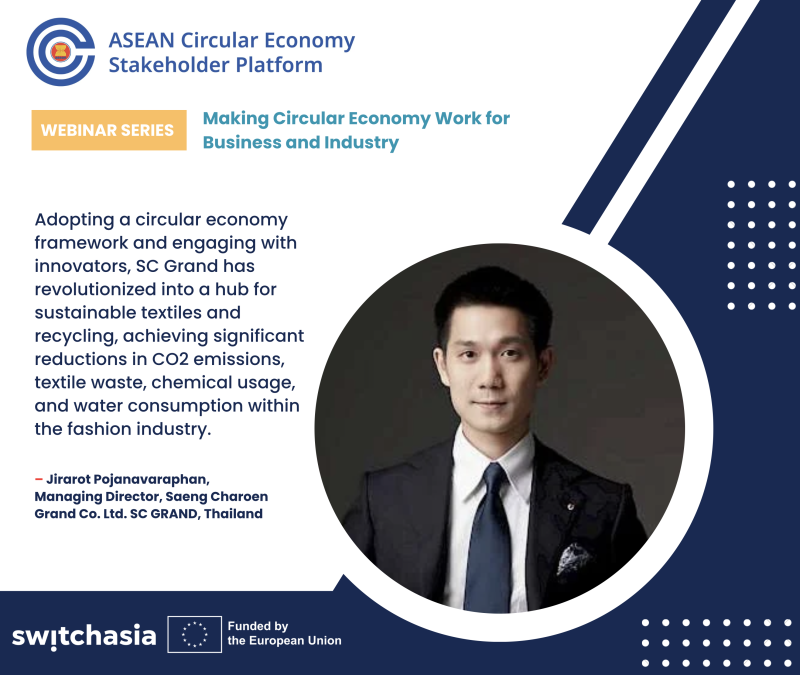
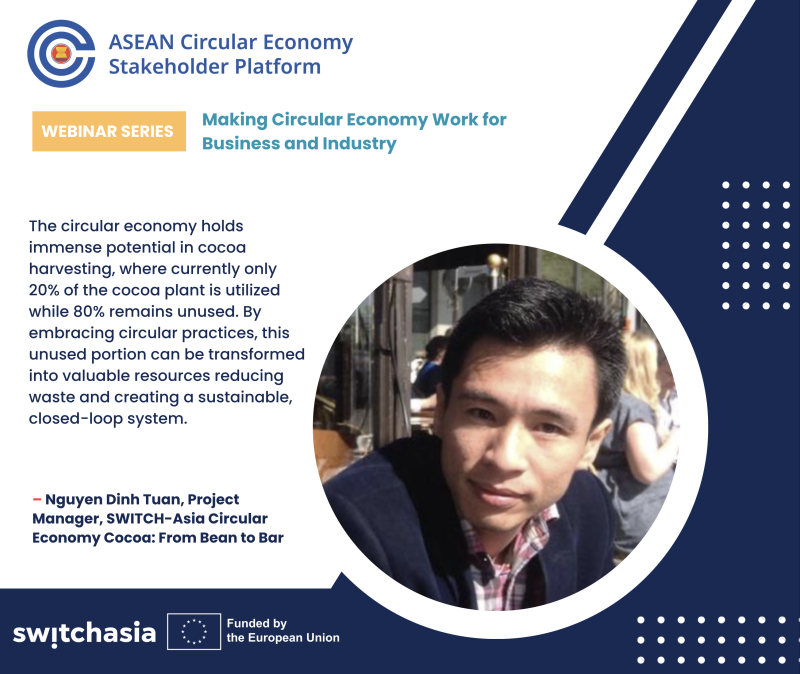
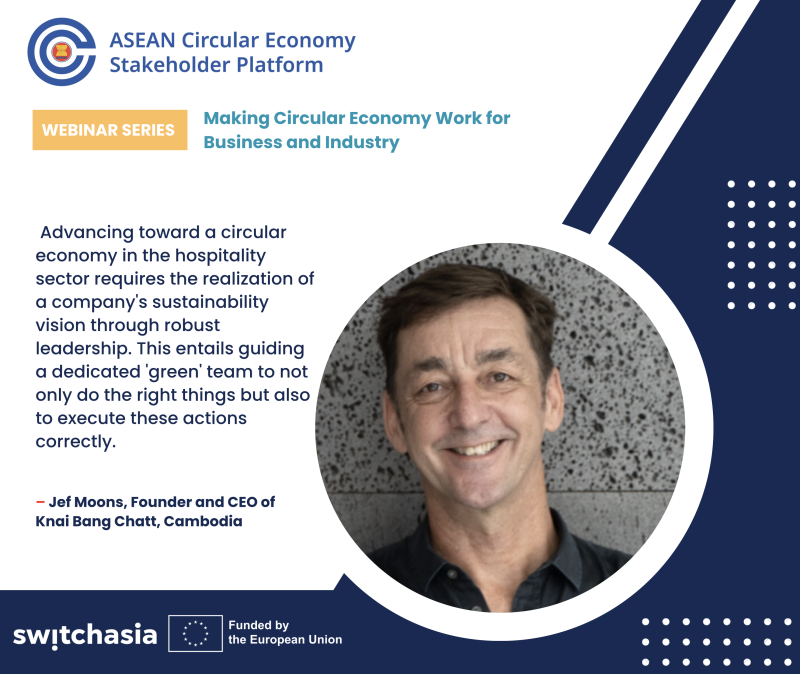
René Van Berkel moderated a session featuring industry experts from three ASEAN member states — Thailand, Vietnam, and Cambodia — showcasing exemplary circular economy practices in the private sector.
Jirarot Pojanavaraphan, Managing Director at SC Grand Thailand, represented the textile industry in Thailand. SC Grand is a family-run textile business, now into its third generation management, that in the past three years SC Grand has been producing new fibre yarns, textiles, and garments from unwanted clothes and discarded garments from factories for private companies and fashion brands. This process includes separating colours of textile waste to create new yarns, which are then woven into new textiles and transformed into garments, such as turning old FedEx uniforms into new caps. SC Grand's commitment to sustainability is evident in its life cycle assessment, performed by a third party in Canada, showcasing the environmental benefits of using recycled yarns. Their model addresses several issues: reducing raw material extraction, managing textile waste, and conserving water and chemicals used in fibre crop farming and yarn manufacturing. SC Grand's initiative is further encouraged by global regulations like carbon credits, taxes, and incentives, motivating local and global brands to participate in this sustainable approach.
The second case study, presented by Nguyen Dinh Tuan, Project Manager at Helvetas Swiss Intercooperation, focused on the EU SWITCH-Asia Circular Economy Cocoa: From Bean to Bar project in Vietnam. This project assists cacao farmers and businesses in adopting regenerative practices. It began with a value chain analysis and life cycle assessment for the cacao sector to identify intervention priorities. The project supports cacao farmers in utilizing waste materials effectively, such as using cacao pods for animal feed and irrigation, and transforming cacao pulp into wine and liqueurs. These practices add value to what would otherwise be waste, diversifying the value chain and attracting new buyers. The project also promotes other regenerative agriculture practices, like using cacao leaves as mulch and employing ants for pest control.
The final case study, presented by Jef Moons, Founder and CEO of Knai Bang Chatt, showcased this sustainable boutique luxury beach resort in Cambodia. The resort, certified with the Platinum Certification from Green Growth 2050 standards, incorporates circular economy principles in its operations. Over the past decade, their practices have yielded financial and non-financial benefits, such as offering a guilt-free travel model to travellers. The resort's approach to circularity involves creating a sustainable team consisting of all heads of departments with a mindset geared towards circular practices, regular review and reflection meetings to learn from failures and successes, and providing a trustworthy template that local people, hotel owners, and international travellers can follow. This model emphasizes performance, transparency, and accountability against standards and indicators, showcasing that circular economy practices can be effectively integrated into the hospitality industry.
Each of these cases highlights the diverse applications of circular economy principles across different industries and the tangible benefits they offer, not only in terms of sustainability but also in driving economic and operational efficiencies.
Panel Discussion
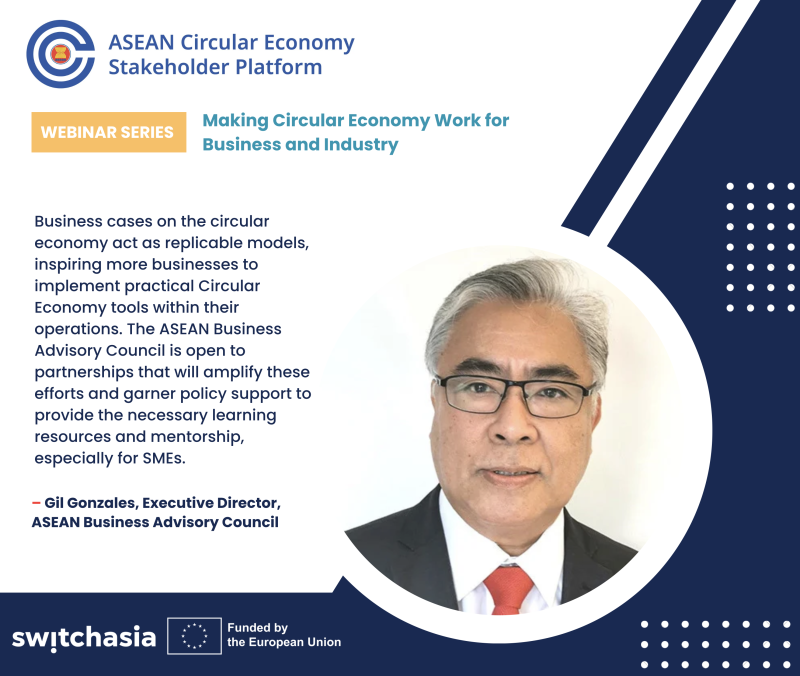
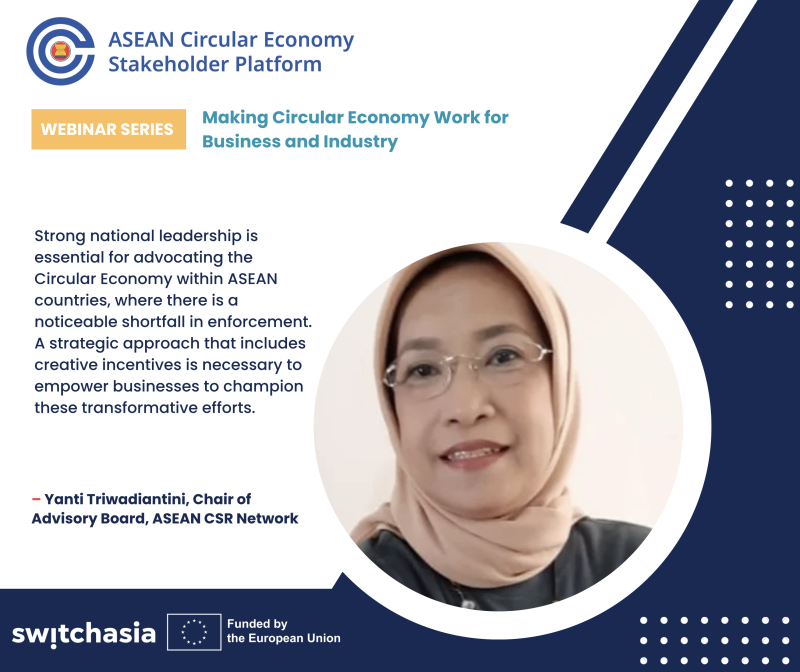
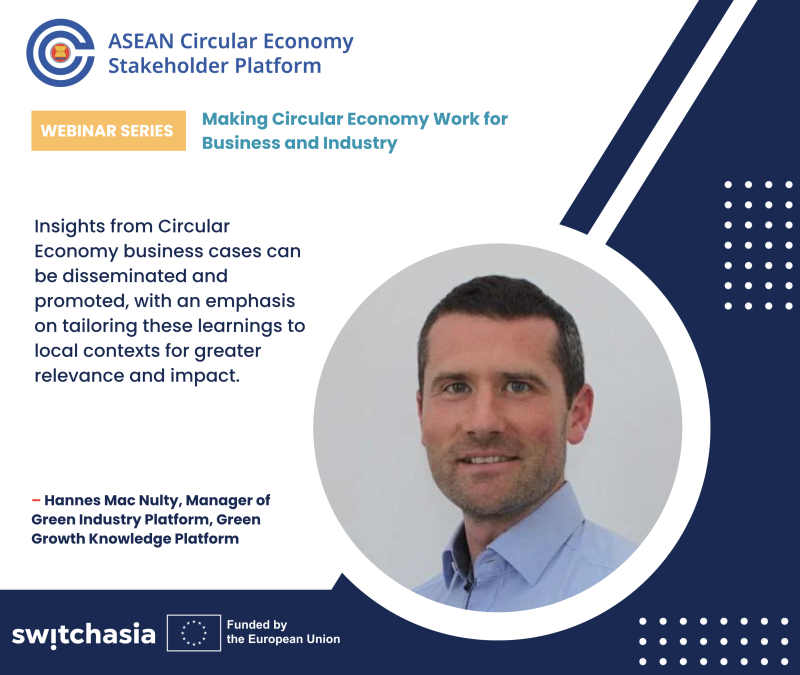
The session moderated by Thomas Thomas, CEO of the ASEAN CSR Network and Expert for the SWITCH-Asia Policy Support Component, engaged with circular economy enablers from three regional organizations. This discussion focused on how these entities facilitate the adoption and implementation of circular economy practices across various sectors in the ASEAN region.
Gil Gonzales, from the ASEAN Business Advisory Council, emphasized that only a small fraction of companies have successfully transitioned into the circular economy. This highlights the need for effective platforms to support and reform private sector institutions towards sustainability and circularity. He pointed out that showcasing successful cases is crucial for learning and transformation, as these instances serve as replicable models and motivation for other companies to follow.
The panel stressed the government's role in establishing policies and providing mentorship, particularly to MSMEs, to understand the circular economy's benefits. Strategic partnerships with industry and knowledge partners are essential in disseminating innovations and a deeper understanding of circular economy practices. Private sector participation is also critical in refining these reforms and sharing practical experiences.
Yanti Triwadiantini from the ASEAN CSR Network pointed out how each industry and business leader applies circular economy principles in their unique context, as there is no universal model applicable to every industry. Leadership and sustainability-focused teams within organizations are vital for crafting and implementing successful strategies. Moreover, creating an enabling and inclusive environment with fair regulations is crucial, as is strong national leadership to prioritize circular economy initiatives.
The circular economy involves both producers' and consumers' perspectives, influencing and driving each other's actions. While it can be challenging to foster sustainable consumption practices among consumers, clear economic, social, and environmental benefits can encourage producers to adopt circular practices. Collaborative efforts among industries, supported by governments and regional organizations, are necessary to bring the entire value chain towards a circular economy model.
Hannes Mac Nulty from the Green Growth Knowledge Platform affirmed that despite the opportunities presented by the circular economy, such as environmental and financial benefits, challenges persist in involving all stakeholders and creating viable business cases across supply chains. Policy complications and the need for a global approach add to these challenges. Different local, regional, and global supply chains, influenced by varying cultures and market forces, require tailored approaches.
Successful business cases that demonstrate responsibility to consumers and motivate the supply chain to embrace resource efficiency are key. Support and accurate information from enablers are crucial in achieving a truly circular and inclusive value chain. Such successful examples can help shape policies more rapidly and effectively.
The journey towards a circular economy requires scaling through capacity building, market opportunities, and financial support. A value chain approach, rather than a sector-specific one, is crucial for effective implementation, allowing lessons learned in one sector to be applied in another. Cross-sector collaborations and competitive dynamics within sectors can further accelerate the adoption of circular economy practices. This comprehensive approach underlines the importance of partnerships and collaborative efforts in this transformative journey.
 Key Takeaways
Key Takeaways
These key takeaways from the webinar offer a comprehensive overview of the challenges, strategies, and opportunities in the transition to a more sustainable and efficient economic model:
1. Decoupling Economic Growth from Resource Utilization: ASEAN has the potential to separate economic growth from resource exploitation and environmental impact by adopting circular economy practices.
2. Vital Role of Business and Industry: The private sector is instrumental in driving the transition towards a circular economy, showcasing its critical role in sustainable development.
3. Broadening the Circular Economy Definition: The concept of circular economy should extend beyond just recycling and waste management to address broader environmental crises, including climate change and biodiversity loss.
4. Innovative Resource Circulation: Circular economy is about innovating to circulate resource use more efficiently.
5. Triple Bottom Line of Circular Economy: The three key strategies in circular economy are Resource Circularity, Resource Efficiency, and Resource Substitution.
6. Guiding Principles for Business Action: These principles aim to unify the ASEAN private sector’s approach to circular economy, focusing on net zero commitments, resource use strategies, responsible practices, and mitigating economic and social impacts.
7. Environmental Benefits: Circular economy simultaneously addresses the need for less resource extraction and the diversion of waste and pollution from the environment.
8. Value Addition and Diversification: Creativity and innovation within circular economy practices can add significant value to businesses and attract more buyers and investors.
9. Financial Benefits: Circular economy practices are not only environmentally sustainable but also financially beneficial.
10. Importance of Leadership and Teamwork: Effective implementation in the private sector requires strong leadership and a dedicated team.
11. Role of Enablers: Entities that enable circular economy play a crucial role in connecting, mentoring, replicating, and amplifying success stories.
12. Customized Approaches: There is no universal model for circular economy success; strategies need to be tailored to specific industries and businesses.
13. Need for Collaboration: Achieving a circular economy requires participation and collaboration from all stakeholders across the value chain.
14. Consumer Responsibility: Business practices that are responsible towards consumers can motivate the entire supply chain towards resource efficiency and circularity.
15. Role of Policies: While policy development can be slow, non-governmental stakeholders, particularly in the private sector, can expedite the adoption and effective implementation of circular economy practices.
16. Necessity of Scaling: Scaling circular economy practices is essential for broader impact and can be achieved through capacity building, market development, and financial support, utilizing a value chain approach.
17. Importance of Partnerships: Success in circular economy requires partnerships and collaboration, as no single entity can achieve this transformation alone.
Related Resources
- Video recording available here
- Event info at ASEAN Circular Economy Stakeholder Platform and EU SWITCH-Asia
Acknowledgment
This Knowledge Brief was prepared by Dr. Sirasa Kantaratakul, the EU SWITCH-Asia Policy Support Component (PSC) and the ASEAN Circular Economy Stakeholder Platform. The information and contents in this document are the sole responsibility of the authors and do not necessarily reflect the views of the European Union.



